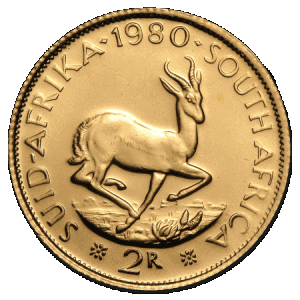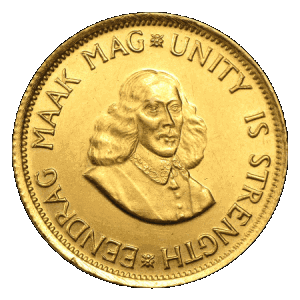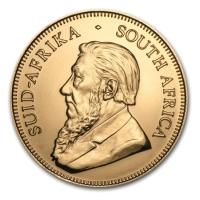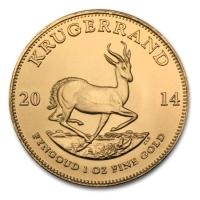South African Gold Rand

 South African Rand gold coins - the predecessors of the Gold Krugerrands
South African Rand gold coins - the predecessors of the Gold Krugerrands
The 1 and 2 South African Rand gold coins are the predecessors of the 1/10 oz and 1/4 oz Gold Krugerrands. The coins were minted by the South African Mint between 1961 and 1983. Minted out of 91.67% pure gold, the 1 Rand gold coin has an actual gold weight of 0.1177 oz whereas the 2 Rand gold coin has an actual gold weight of 0.2354 oz. When you buy gold in the form of these coins, you'll own rare gold coins that are increasingly difficult to find listed for sale online. Total mintage of the South African Gold Rand was limited to about half a million coins for each denomination.
The South African Gold Rands are available as almost uncirculated, brilliant uncirculated and proof coins. Both denominations of Gold Rands depict an image of South Africa's springbok antelope on the reverse just like on other South African gold coins. The obverse side of the coins shows a portrait of the former Dutch commander of the Cape Jan van Riebeeck.
There exist two versions of both the 1 and 2 Gold Rand coin. One version was destined for export and the other for the South African domestic market. It is nearly impossible to distinguish the export version of the coins from the inland version with a proof finish. That is significant since the export version of the South African Rand gold coins cannot be legally traded within South Africa. American buyers that are investing in gold for their retirement should take note that all versions of the South African Gold Rand are not eligible for inclusion in Individual Retirement Accounts (IRA's) since they are classified as collectible gold coins by the IRS.


Coin Fact Sheet
| Weight | Face Value | Purity | Diameter x Thickness |
|---|---|---|---|
| 0.2354 oz | 2 Rand | 91.67% | 22 x 1.83 mm |
Total Mintage: 231,755 + 249,958 proof coins
| Weight | Face Value | Purity | Diameter x Thickness |
|---|---|---|---|
| 0.1177 oz | 1 Rand | 91.67% | 19.43 x 1.09 mm |
Total Mintage: 269,364 + 234,958 proof coins
Design of the South African Gold Rands
The obverse side of the 1 and 2 Gold Rand coins is adorned with the portrait of Jan van Riebeeck. He was the 1st Commander of the Cape during Dutch colonial times and is regarded as the founder of the city of Cape Town. Especially the Afrikaner population of South Africa consider him as one of the founding fathers of the nation. Van Riebeeck's portrait is skillfully engraved with such fine details as the lace on his collar and his long coiffure. His portrait is encircled by the English and Afrikaan phrase "Unity is Strength" ("Eendrag Maak Mag").
The design on the reverse side of the 1 and 2 South African Gold Rands was created by the South African sculptor Coert Steynberg and introduced in 1948 for the 5 shilling coin. It shows South Africa's springbok antelope frolicking through the savanna. The words "SOUTH AFRICA" and its Afrikaans equivalent "SUID-AFRIKA" are inscribed along the coin's edge. The year of mintage appears above the springbok antelope and the denomination of either 1R or 2R is inscribed below it. The English and Afrikans inscriptions of the country's name and motto on the reverse and obverse side trade places from one edge of the coin to the other when comparing the South African 1 Rand gold coin (1R) with the South African 2 Rand gold coin (2R).
History of the Gold Rands
The South African 1 Rand gold coin matches the size of the British Half Sovereign and the South African 2 Rand gold coin is of the same size as the British Gold Sovereign. These British coins had been minted at the Pretoria branch of the Royal Mint until 1932. From 1952 on, 1 Pound and 1/2 Pound gold bullion coins were issued that had the same dimensions as well. The Gold Rands in the denominations of 1 and 2 Rand replaced the Pound and half-Pound coins in 1961. The South African Mint in Pretoria minted the Gold Rand coins until 1983. At that time, they were replaced by the fractional 1/10 oz and 1/4 oz Gold Krugerrands. Even though the 1 and 2 South African Rand gold coins aren't minted any longer, they still have the status of legal tender in South Africa. They are difficult to find in circulation now though.
Export Version of the Gold Rand Coin
Besides the coin version that was destined for inland circulation, the South African Mint also produced an export version of the 1 and 2 Gold Rand coin that is illegal to trade in South Africa. The mintage of export coins far exceeded the mintage intended for inland circulation. A certain number of export coins were produced with a proof finish but even 'regular' export coins were produced with a proof-like finish. That makes it almost impossible to distinguish the proof version of the rarer inland coins from the more abundant export coins.
Mintage Numbers
Annual mintage of the 1 Rand gold coin varied between 3,955 and 27,000 coins (proof coins between 2,344 and 21,000 coins). For the 2 Rand gold coin, mintage varied between 2,030 and 18,000 coins (proof coins between 2,344 and 21,000 coins).


South African Gold Krugerrands
The South African Gold Krugerrand coins dominated the world's gold coin market for a long time and are still the most traded gold bullion coins in the world. The coins are so named because a portrait of Paul Kruger, the 5th president of the South African Republic from 1883 until 1900, appears on their obverse side. They are minted by the South African Mint out of 91.67% pure gold since 1967. Gold Krugerrands are legal tender in South Africa even though there is no face value imprinted on them. The coins are offered with brilliant uncirculated and proof finishes in the four denominations of 1 oz, 1/2 oz, 1/4 oz and 1/10 oz.
The South African Gold Krugerrand page gives more information about the coins and allows you to compare current prices.